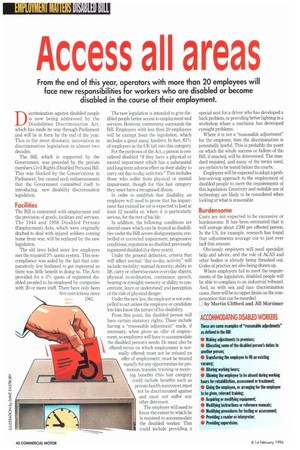M tgli tICIL I1iI114 0.1:11111 :i1111
Page 42

If you've noticed an error in this article please click here to report it so we can fix it.
Access all areas
From the end of this year, operators with more than 20 employees will face new responsibilities for workers who are disabled or become disabled in the course of their employment.
Discrimination against disabled people is now being addressed by the Disabilities Discrimination Act, which has made its way through Parliament and will be in force by the end of the year. This is the most dramatic innovation in discrimination legislation in almost two decades.
The Bill, which is supported by the Government, was preceded by the private members Civil Rights (Disabled Persons) Bill. This was blocked by the Conservatives in Parliament, but caused such embarrassment that the Government committed itself to introducing new disability discrimination legislation
Facilities
The Bill is concerned with employment and the provision of goods, facilities and services. The 1944 and 1958 Disabled Persons (Employment) Acts, which were originally drafted to deal with injured soldiers coming home from war, will be replaced by the new legislation.
The old laws failed since few employers met the required 3% quota system. This noncompliance was aided by the fact that comparatively few bothered to get registered as there was little benefit in doing so. The Acts provided for a 3% quota of registered disabled peopled to be employed by companies with 20 or more staff. There have only been five convictions since 1961. The new legislation is intended to give disabled people better access to employment and services. However, controversy surrounds the Bill. Employers with less than 20 employees will be exempt from the legislation, which includes a great many hauliers. In fact, 83% of employers in the UK fall into this category.
For the purposes of the Act, a person is considered disabled "if they have a physical or mental impairment which has a substantial and long-term adverse effect on their ability to carry out day-to-day activities." This includes those who suffer from physical or mental impairment, though for this last category they must have a recognised illness.
In order to establish that disability, an employee will need to prove that his impairment has existed for (or is expected to last) at least 12 months or, where it is particularly serious, for the rest of his life.
In addition, the following conditions are special cases which can be treated as disabilities under the Bill: severe disfigurements; controlled or corrected impairment; progressive conditions; reputation as disabled; previously registered disabled (for three years).
Under the general definition, criteria that will affect normal "day-to-day activity" will include: mobility; manual dexterity; ability to lift, carry or otherwise move everyday objects; physical co-ordination; continence; speech, hearing or eyesight; memory or ability to concentrate, learn or understand; and perception of the risk of physical danger.
Under the new law, the employer is not compelled to act unless the employee or candidate lets him know the nature of his disability.
From this point, the disabled person will have certain statutory rights. These include having a "reasonable adjustment" made, if necessary, when given an offer of employment, so employers will have to accommodate the disabled person's needs. He must also be offered terms on which employment is nor mally offered; must not be refused an offer of employment; must be treated equally for any opportunities for promotion, transfer, training or receiving benefits (this last category could include benefits such as private health insurance); must not be discriminated against and must not suffer any other detriment.
The employer will need to know the extent to which he is required to accommodate the disabled worker. This could include providing a special seat for a driver who has developed a back problem, or providing better lighting in a workshop where a mechanic has developed eyesight problems.
Where it is not a "reasonable adjustment" for the employer, then the discrimination is potentially lawful. This is probably the point on which the whole success or failure of the Bill, if enacted, will be determined. The standard required, and many of the terms used, are certain to be tested before the courts.
Employers will be expected to adopt a problem-solving approach to the employment of disabled people to meet the requirements of this legislation. Creativity and suitable use of technology are likely to be considered when looking at what is reasonable.
Burdensome
Costs are not expected to be excessive or burdensome. It has been estimated that it will average about .£200 per affected person. In the US, for example, research has found that adjustments average out to just over half this amount.
Obviously employers will need specialist help and advice, and the role of ACAS and other bodies is already being thrashed out. Codes of practice are also being drawn up.
Where employers fail to meet the requirements of the legislation, disabled people will be able to complain to an industrial tribunal. And, as with sex and race discrimination cases, there will be no upper limits on the compensation that can be awarded.
LI by Martin Clifford and Jill Mortimer
ACCOMMODATING DISABLED WORKERS
These are some examples of "reasonable adjustments" as defined in the Bill: Making adjustments to premises: Allocating some of the disabled person's duties to another person; Transferring the employee to fill an existing vacancy; • Altering working hours; Allowing the employee to be absent during working hours for rehabilitation, assessment or treatment Giving the employee, or arranging for the employee to be given, relevant trainin • Acquiring or modifying equipment; • Modifying instructions or reference manuals; • Modifying procedures for testing or assessment • Providing a reader or interpreter • Providing supervision,




































































































